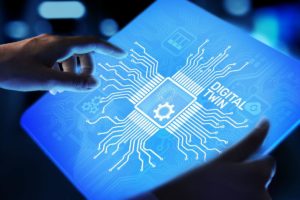As a consultant to NASA, the concept of the digital twin, introduced by Dr Michael Grieves in 2002, has become more common in recent years thanks to the widespread use of Internet of Things (IoT) technology. In this article, we tell you what you need to know about digital twin technology, which has become popular with the effect of being recognised as one of the top 10 strategic technology trends by Gartner in 2018.
What is a digital twin?
Digital twin technology is one of the most curious topics in the digitalising industry. It is possible to answer the question of what is a digital twin is “a copy of a physical object, animate or inanimate, in a digital environment”.
Broadly speaking, it is an example of the transformation of physical data into digital data, as a modelling technology that maps digital objects to physical objects. This technology, which is based on the creation of a digital copy of the product without being physically made, can be seen as a reflection of the Industry 4.0 vision.
What is the benefit of the digital twin?
Thanks to the digital twin technology, unpredictable project delays are reduced, the result of the change can be learned quickly, and time and money can be saved. Digital twin works in sync with the internet of things (IoT), machine learning (ML) and artificial intelligence (AI) technologies. Examples of digital twins can be encountered in many sectors, from automotive to smart cities, from healthcare to manufacturing technologies.
How to make a digital twin?
According to Michael Grieves, the author of the book “PLM: Driving the Next Generation of Lean Thinking”, constructing a virtual structure that includes a digital twin requires three factors: The product to be created in the real environment, the virtual state, and the data that creates the link between the real product and the virtual product.
The digital twin technology works by processing data such as operating conditions, real-time situations and location from the device, supported by sensors and operating following the principle of the internet of things, according to a model with advanced analytical features and producing output. In this process, the digital twin is counted among the most important Industry 4.0 technologies, due to the unique provision of information in the production process.
Thanks to the ability to extend the life of the object it represents and increase operating performance, the digital twin adds value to the way they work by reducing operating and potential capital expenditures. Taking advantage of digital twin technology for testing complex products that are difficult to test and financially burdensome stands out as a unique advantage.

Digital Twin Usage Areas
Design and Product Development: It is the creation of alternatives in projects and the discovery of their effects, tests and simulations for how adequate the design can be. All these are carried out quickly in the digital environment and with the information obtained, decisions about the product are made more healthily.
Production and Assembly: It reveals how factors such as quality, cost and efficiency in the production process will affect the manufacturing process through digitalisation. In addition to these, digital modelling of the factory or production line can be made to operate the factory and evaluate the results. In this way, the best working system can be established.
Operational Activities: This technology also provides many benefits in operational and service processes. It is ensured that malfunctions are prevented and detected before they occur, remote monitoring of the system or product, remote resolution of the problems that occur, and the development of warning systems.

Will humans have Digital Twin in the next step?
The creation of digital twins of people has been discussed for a long time, and it is said that this will provide a great advantage, especially in the field of health. It is thought that by combining processes at the cell, tissue and organ level, each individual’s physiological and pathological twin can be created. Creating digital human twins is of course more complex than creating a digital copy of a locomotive. It requires both the collection of data on a larger scale and the circumvention of some legal procedures, but considering the advantages, it will provide, it has great potential.
Test processes on humans, which require more volunteers at each stage, can be redesigned thanks to digital twins. Tests to be carried out in the digital environment can reduce existing risks, shorten the process, and provide a more target-oriented and efficient work. In addition, thanks to digital twins, early diagnosis and diagnosis can be made; The progression of a disease, the effectiveness of the treatment applied, or what the current lifestyle will bring in the future can be predicted. For example, millions of people upload their photos to various mobile apps to find out what they will look like when they get old or what their kids will look like. Thanks to digital twins, we will be able to get clearer answers to these questions.
To sum up, with digital twin technology, we can detect and take action before a problem occurs, save time and money, and make smart decisions by predicting the future. Digital twins, which is an inspiring technology in every way, try to answer all the questions that start with “I wonder what happens if this happens, and let’s assume”.











